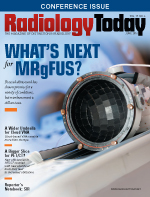 June 2016
June 2016
Radiology Billing and Coding: Coding for CT Imaging of the Abdomen and Pelvis
By G. John Verhovshek, MA, CPC
Radiology Today
Vol. 17 No. 6 P. 6
The abdomen and pelvis frequently undergo CT imaging at the same time, for instance to evaluate a patient following trauma or for conditions such as appendicitis, diverticulitis, ulcerative colitis, and cancer.
The following three CPT codes describe same-session CT imaging of the abdomen and pelvis:
• 74176, Computed tomography, abdomen and pelvis; without contrast material;
• 74177, Computed tomography, abdomen and pelvis; with contrast material(s); and
• 74178, Computed tomography, abdomen and pelvis; without contrast material in one or both body regions, followed by contrast material(s) and further sections in one or both body regions.
Report 74176 when both studies (abdomen and pelvis) are performed without contrast. Apply 74177 if both studies are performed with contrast. Use 74178 if one or both studies is/are performed without contrast, followed by further sections using contrast material(s); and, when one study (of either the abdomen or pelvis) is performed without contrast, and the second study is performed with contrast.
A note about contrast: Per American Medical Association guidelines, oral and/or rectal contrast administration alone does not qualify as a study "with contrast," which applies to those procedures performed using contrast material administered intravascularly, intra-articularly, or intrathecally.
CPT Assistant ("Coding Brief: Computed Tomography of Abdomen and Pelvis," November 2011) describes a typical encounter for 74177 as, "A 66-year-old female with a history of non-Hodgkins lymphoma presents with flank and abdominal pain. Previous examination(s) demonstrated abnormally enlarged abdominal and retroperitoneal lymph nodes. A CT scan of the abdomen and pelvis with intravenous contrast is ordered." It details a typical encounter for 74178 as, "A 50-year-old male presents with vague flank pain and persistent hematuria on serial urinalyses. There is no history of trauma. A CT scan of the abdomen and pelvis with and without contrast is ordered."
Report a single code (74176, 74177, 74178) per claim. In the unusual case that a patient undergoes more than one combined study per day and the services are documented appropriately, you may report both combined studies, with modifier 59, Distinct procedural service, appended to the second code. CPT Assistant (November 2011) specifies, "Although it would be rare, combination CT abdomen/pelvis studies may be performed in the morning followed by combination CT abdomen/pelvis studies performed later on the same day. In that instance, the second combined code should be reported with modifier 59 to denote to the payer that this is not a duplicate bill, but that separate and distinct combined studies were performed during different sessions by the same physician on the same patient on the same day."
Look to Different Codes for Imaging of Either the Abdomen or Pelvis Alone
CPT also includes the following codes for CT of the abdomen only, and for CT of the pelvis only:
• 74150, Computed tomography, abdomen; without contrast material;
• 74160, Computed tomography, abdomen; with contrast material(s);
• 74170, Computed tomography, abdomen; without contrast material, followed by contrast material(s) and further sections;
• 72192, Computed tomography, pelvis; without contrast material;
• 72193, Computed tomography, pelvis; with contrast material(s); and
• 72194, Computed tomography, pelvis; without contrast material, followed by contrast material(s) and further sections.
To help you to select the appropriate code when reporting CT of the abdomen and/or pelvis (with, without, or with and without contrast), the CPT codebook provides a quick-view coding tool.
Typically, you will not report a combined study with a CT of the abdomen or pelvis alone. The National Correct Coding Initiative (NCCI) includes edits to prevent reporting stand-alone CT abdomen (74150 to 74170) and CT pelvis (72192 to 72194) codes on the same day of service as the combination CT abdomen and pelvis codes 74176 to 74178. However, CPT Assistant (November 2011) allows for exceptions: "[M]odifier 59 [Distinct procedural service] should be appended to the stand-alone codes, when appropriate, to designate to the payer that the procedure was performed during a separate patient encounter and not during the same session as the combined CT abdomen and pelvis studies.
"For example, CT abdomen and pelvis with contrast studies are performed at 1 PM for rectal bleeding and to evaluate the patient for possible colitis. A hyperdensity is identified within the cecum, which could represent a foreign body vs active extravasation. A noncontrast CT of the pelvis is performed at 3 PM to assess for resolution. Because there are NCCI edits in place, modifier 59 should be appended to the CT pelvis code to designate that a separate and distinct study was performed during a different session."
In other words, if a combined study and a same-day individual study are supported, you may report the individual study separately with modifier 59 appended. Documentation must verify the distinct nature and medical necessity for both procedures.
CPT Assistant concludes with a reminder that modifiers are payer specific and recommends that practices contact their local carriers and other third-party payers for instructions on the use of modifiers.
— G. John Verhovshek, MA, CPC, is managing editor for AAPC, the nation's largest medical credentialing organization.

